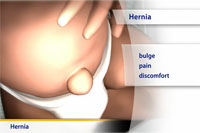
Hernias
What is a hernia?
A hernia is a condition in which part of the intestine (bowel) bulges through a weak area in the abdominal muscles. Hernias are common in children.
How does it occur?
Most hernias in children occur before birth. In some babies, some of the muscles in the abdomen do not completely come together before birth. This leaves a small opening below the skin.
A common area for hernias to develop is the belly button. This is called an umbilical hernia. A groin (inguinal) hernia occurs in the groin. The groin is the area below the belly where the legs join the body. Premature babies are more likely to have an inguinal hernia than term babies. Other types of hernias happen much less often.
What are the symptoms?
A hernia is usually diagnosed by seeing or feeling an abnormal bulge in the belly button or groin area. It often gets bigger when the baby cries, coughs, or strains. Less often, there is pain or discomfort in the lower belly or groin.
It is important for a hernia to eventually close. This prevents the intestines or other parts of the inner abdomen from staying pushed through the opening in the abdominal wall. This happens more often with an inguinal hernia. When this happens, food may not move properly through the intestines. The intestines may be blocked, causing pain, redness, swelling, and sometimes vomiting. Part of the intestine can also stop getting a supply of blood. This is an emergency.
How is a hernia diagnosed?
Parents sometimes will notice the bulge or your healthcare provider may find it during an exam.
How is it treated?
Most umbilical hernias do not need special care or treatment unless they do not go away on their own before a child is 4 to 6 years old. Large umbilical hernias or hernias where the bowel can't be pushed back into the abdomen may need surgery. Covering an umbilical hernia with tape or other material will not cause it to go away faster.
Inguinal hernias need to be fixed by surgery. If the intestines push through a hernia and cannot be pushed back into the abdomen, surgery is needed right away. Although the surgery to correct a hernia is relatively minor, there are some risks with using anesthesia on young babies. Ask your healthcare provider when it is best to fix the problem with surgery.
When should I call my child's healthcare provider?
Call right away if your child has:
- pain, increased swelling, or redness at the location of a hernia
- a hernia that is getting larger, which you cannot push back into the abdomen
Last modified: 2011-05-10
Last reviewed: 2011-05-09

